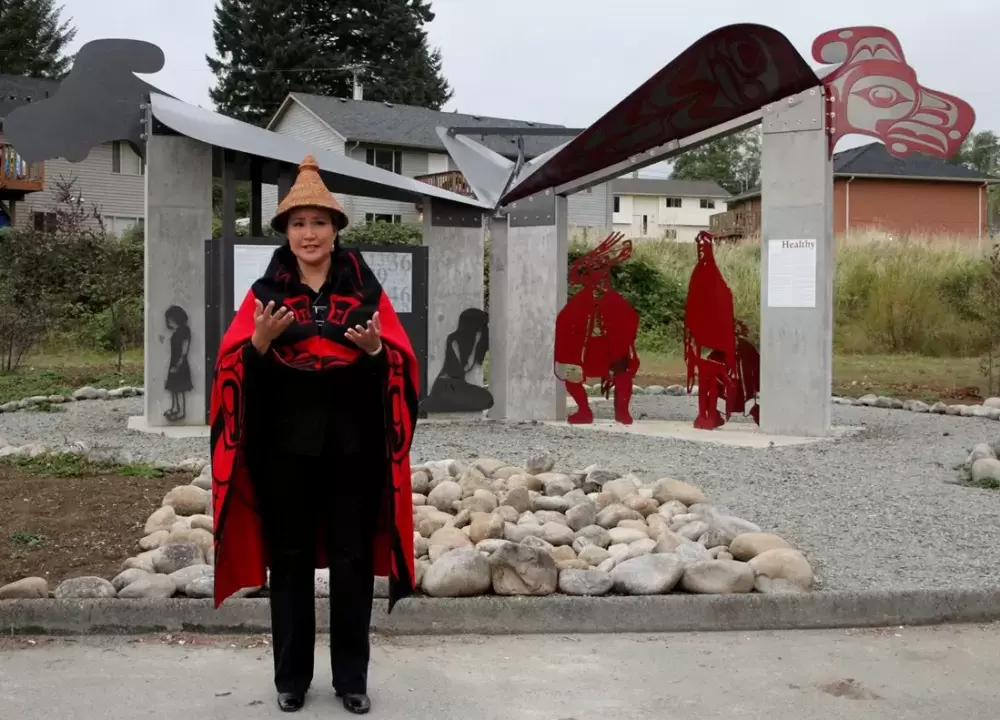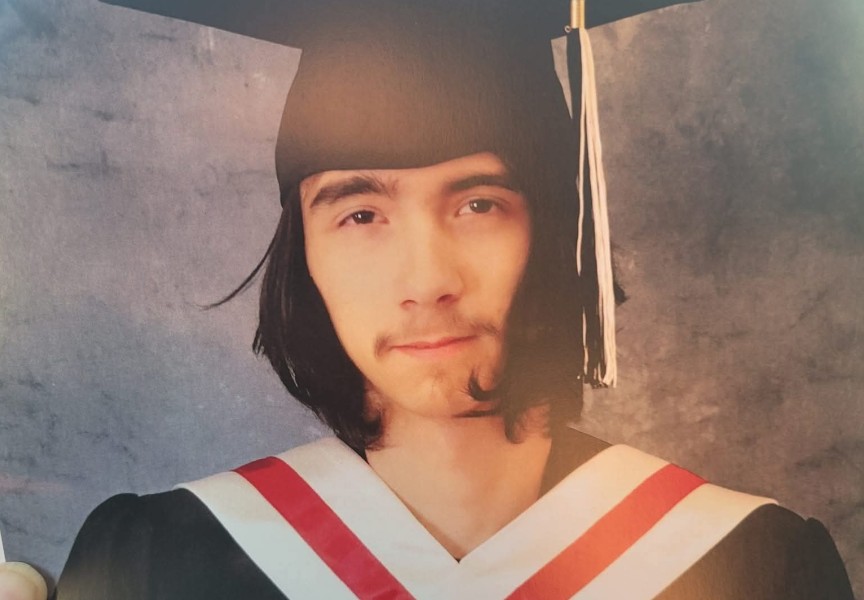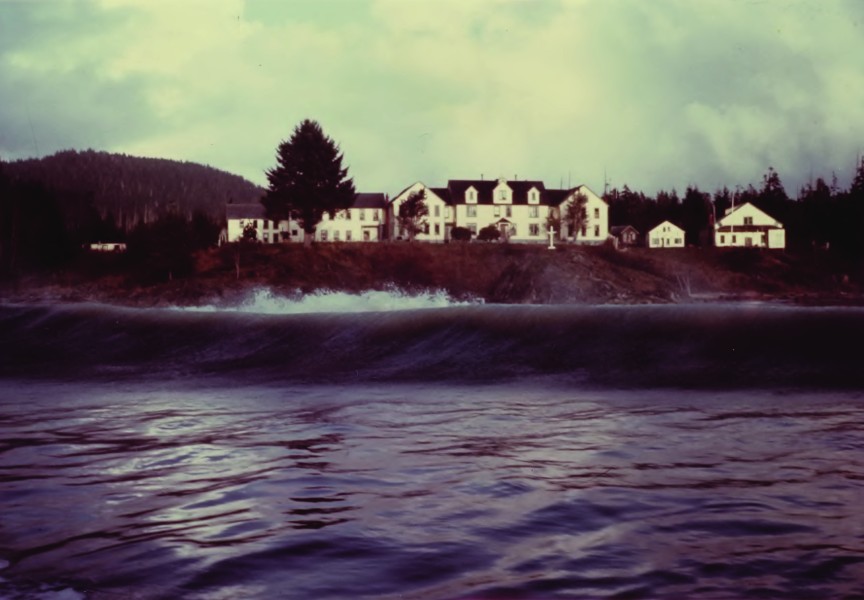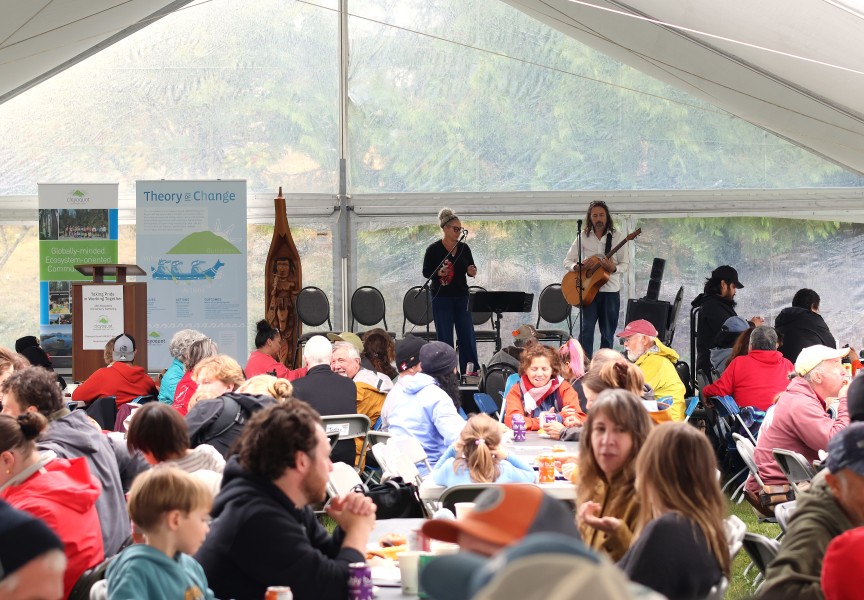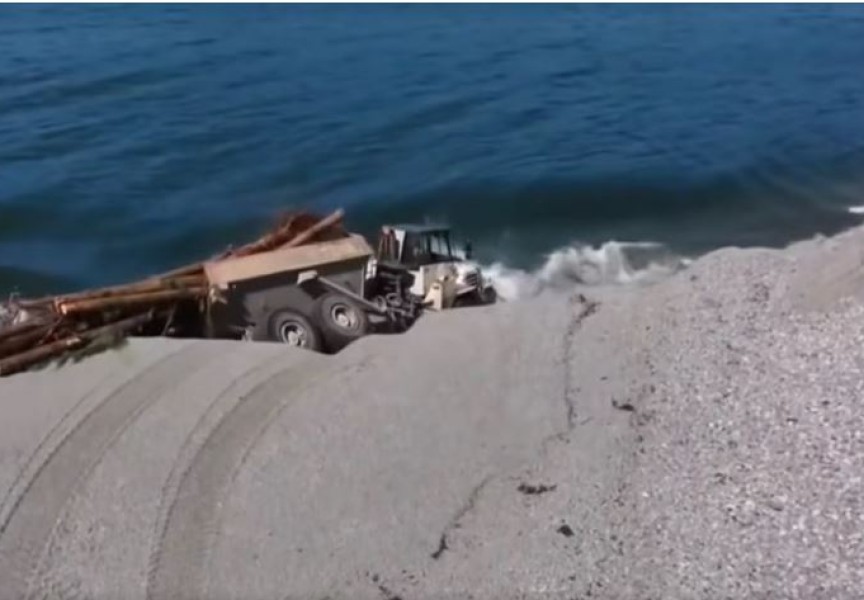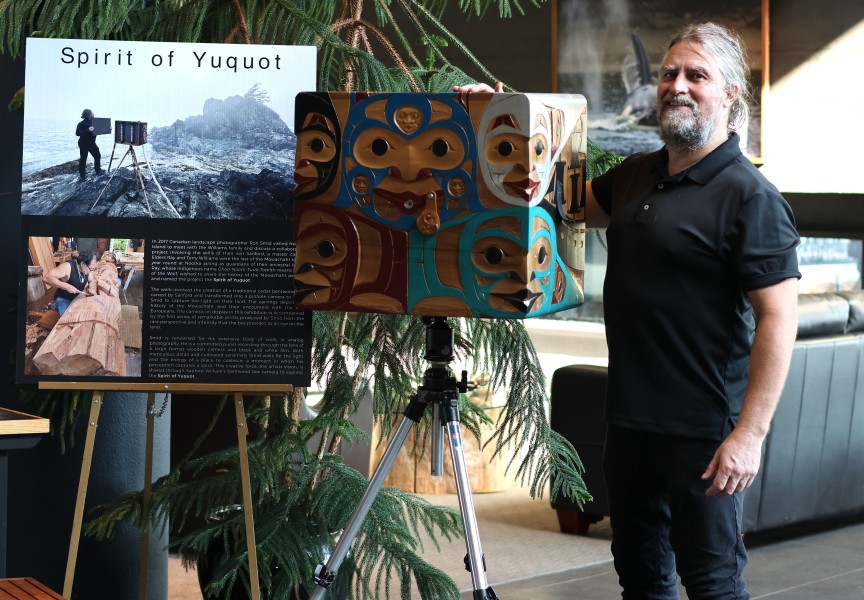“Strength from Within”, a sculpture by Tseshaht’s own Connie Watts, was officially unveiled on Oct. 1, life brought into it through a brushing ceremony.
It stands next to the Tseshaht longhouse and on the site of the notorious former Alberni Indian Residential School. It will serve as a constant reminder to all of the horrors that occurred at AIRS over the decades, to honor all who didn’t return to their families, and pay tribute to the resiliency of all those who survived their time there.
Watts is internationally-celebrated, renowned for such works as Hetux, the West Coast Thunderbird installation at Vancouver International Airport. She donated her time to create the “Strength from Within” project, working with a team of talented individuals.
“It was the hardest thing I’ve ever done,” she said, her voice trembling with emotion. “How dare they call it a school,” she said. “It was a prison. There was no education.” It was “a concentration camp for kids.”
The morning ceremony began with a prayer song sung by Anne Robinson as four young people—Isabel Clutesi, Aaron Watts, Tammy Lucas and Wendy Gallic from Tseshaht—brushed the sculpture with cedar boughs “to get it ready to tell its story,” Robinson told Ha-Shilth-Sa. Albert Clutesi, who sits in the seat for Maqtaa?aht, and his wife Bernice were in attendance.
Wickaninnish Cliff Atleo provided emceeing duties, and introduced Tseshaht Chief Councillor Hugh Braker who described the event as a “wonderful occasion.”
Braker talked about the nearby Haahuupayak School where Nuu-chah-nulth children are again learning their language. He talked about the Nuu-chah-nulth fishermen, who are anticipating another run of fish coming through the river this weekend, and exercising their right to that fish.
“I want the evil people that banned Nuu-chah-nulth culture to know that they lost,” Braker said. He wanted the people that beat the children at AIRS to know that they have lost.
Braker said he wanted the evil and late Arthur Henry Plint, a dormitory supervisor who committed outrageous and ongoing sexual abuse against students at AIRS—“wherever he has gone to” —that he lost.
He said Tseshaht culture and Tseshaht people survived the evil, monstrous things that happened on their land. It will remain a burden to Tseshaht that AIRS was built on their territory, Braker said.
“We are not going to let that school become the definition of our history.”
He invited all Nuu-chah-nulth parents to visit the sculpture and talk to their children about what happened here.”
“Don’t hide it from them,” he said. They need to understand what their parents, grandparents and great-grand parents went through at AIRS so that they can understand why some still struggle with the legacy of the place.
Braker said he is proud that one of Tseshaht’s own devised the concept of the structure.
“We’re not going to let the people that ran the school win.”
The sculpture is dominated by three Thunderbirds. Two are adorned with West Coast designs. The other is devoid of the cultural symbols, representing the darkness and shadow of the residential school era, when children were separated from their people and culture.
An aluminium panel that goes between the two centre columns symbolizes the divide of boys' and girls' sides in the residential school.
Figures are attached to the structure with no identity. “The two outer children figures look morose and longing to be free,” Watts explained to Ha-Shilth-Sa. Two children figures in that section are contained in the square shaped supports. “They are installed horizontally in box type frames that denote the children that were murdered or locked in small closets.”
One Thunderbird flies over the healing side of the structure, as people work to recover from their pain and sadness.
“The Thunderbird wings hold the text ‘Spirit Nation’ and ‘Drum Beat’ with a skateboarder on one wing and a drum group singing on the other… a connected mother and child figure are comforting each other in an embrace, while a father figure is coming back, but the son is holding on to his anger.” Watts said this represents the tie to past torture.
Soon after the sculpture was erected it suffered some vandalism. The “angry boy” got pulled off of the structure. Watts struggled to understand why such a thing would happen, and soon came to terms with the anger that still exists in the community that causes these incidents to occur, she said.
The other Thunderbird oversees the healthy side of the structure, designed in the historic Nuu-chah-nulth style and represents cultural renewal and intact people.
“Under this soaring creature is a symbolic Father, Mother and Children figures dancing our traditional wolf dance. The signage tells of our past, present and future culture: our community in balance, our traditional ways of living, and our healing practices. The figures are freestanding from the structure and close in proximity to each other: happy, strong and celebrating,” said Watts.
The Thunderbirds’ wings collect the rain that represents millions of tears that were shed by the children and their parents. The parent figures on the inner columns are crying with the loss of their stolen children.
Signage on the sculpture tells the stories of residential school survivors through quotes pulled from the Truth and Reconciliation School tapes, said Watts.
Children from Tseshaht school and daycare were invited to put their marks in the cement beneath the healing and healthy sections of the sculpture. Whatever they wanted—a hand print or footprint, a smiley face or sun. The residential school shadow side remains unadorned, representing the students who were not allowed to express themselves creatively.
The sculpture unveiling churned up memories for survivors in attendance. Wickaninnish remembered the fenced off orchard that surrounded the school. Children were starved at AIRS, during many years for scientific study. He said there were many holes in that fence, but the risk for harvesting the fruit was beatings and abuse.
He said “I believe my mom’s prayers protected me for nine years,” grateful he didn’t suffer like many at AIRS did.
Residential school survivors were invited to say a few words. Dolly McRae was Dolly Morgan when she was sent to AIRS from the Gitxsan territory in northern B.C.Many children were sent thousands of miles from their homes and homelands to go to AIRS. She said she came by ferry and bus, and when she got to AIRS a supervisor asked her her name. “It’s Dolly Morgan,” she said. “That’s not a name, it’s a nickname,” said the supervisor, and Dolly’s name on her birth certificate became Dorothy Morgan.
She had been told that her family had named her Dolly because she was premature and her uncle said she was so small “she could fit in a doll box.” After raising a family and when she was about to remarry later in life, Dolly tore up that birth certificate and got a new one with her proper name on it.
Wally Samuel talked about the silver lining of the school, meeting his wife Donna and sharing almost 50 years together. Crying, Donna Samuel said she was severely strapped for speaking her language at AIRS, but she was defiant, and was able to share this information in her Gitxsan mother-tongue.
Artist Connie Watts said the concept for the sculpture was devised through community meetings with Tseshaht members. Rena Soutar of the Haida Nation worked with her on the text. Mike Herold from Herold Engineering was the engineer. Jeff Cleveland from Viking Profile fabricated all the aluminum parts. Les Sam from Sam Construction and Craig Bowerman from Bowerman Excavating created all of the concrete forms and landscape around the sculpture. Ken Watts was key in finding the grant monies and starting the project and there was continued support from the Tseshaht Nation throughout the process.
“I am honoured that they brought all of their amazing talent to this project,” she said.
Robinson said there are people out in the wider world that want residential school survivors to forget about what happened to them.
“We will never forget what happened here... It happened and nobody can make it go away.”

